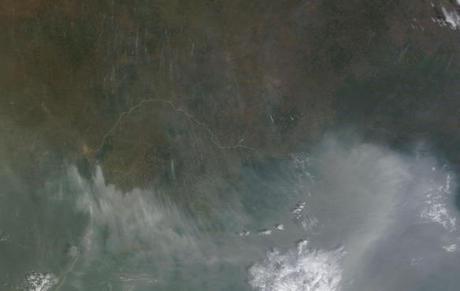Drought and heat combine to expand fire size and extend the burning season. In Arizona, in the 20th Century, lightning ignited the largest fires in early summer when low humidity and high temperature had prepped the vegetation combustion. Human-caused fires during the more-humid conditions of the rest of the year were smaller. However, as things have warmed up and the drought has intensified, large human-caused fires are beginning to flare up in other seasons. The devastating result is that the fire recurrence interval is becoming too short for regeneration by most native perennial plants. Much of the Sonoran Desert is becoming an annual weedland (http://garryrogers.com/2014/01/14/desert-fire/).
 robertscribbler
robertscribbler
The major news organizations haven’t picked it up yet, but there’s a massive wildfire outbreak now ongoing over Central and Western Africa. These wildfires are plainly visible in the NASA/MODIS satellite shot — covering about a 1,400 mile swath stretching from the Ivory Coast, through Ghana, Nigeria and Cameroon and on across the Central African Republic, the Congo, and Gabon.

(Very large wildfire outbreak in Central Africa in the February 10 LANCE-MODIS satellite shot. For reference, bottom edge of frame covers about 350 miles. Image source: LANCE MODIS.)
Smoke from these fires is extremely widespread — stretching over almost all of Western and Central Africa, blanketing parts of Southern Africa and ghosting on out over the Southern Atlantic Ocean. Together with these massive fires we have what appears to be a rather significant CO2 plume showing up in the Coperinicus monitoring system (see below). It’s a signature reminiscent of…
View original post 936 more words

